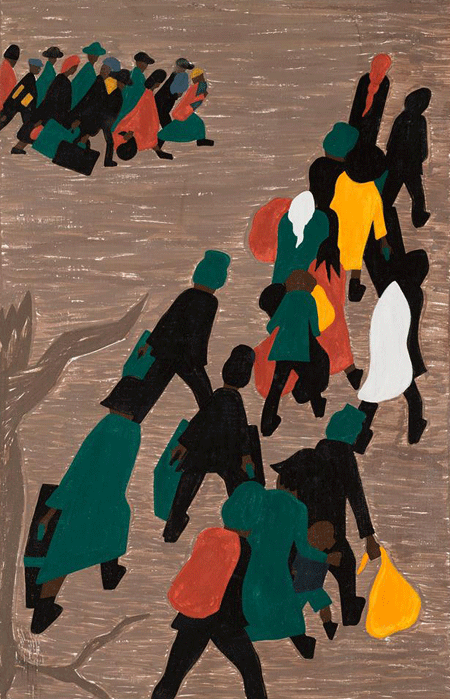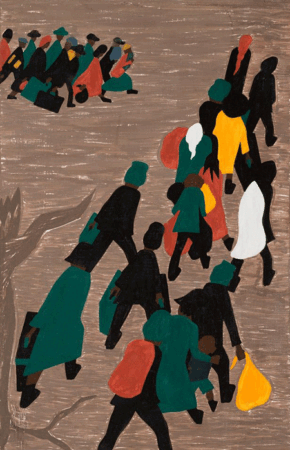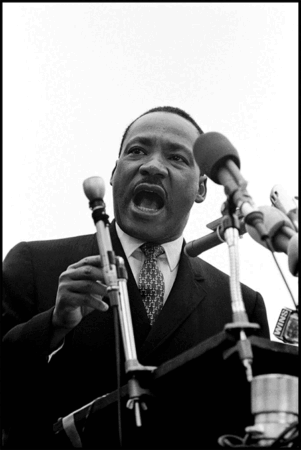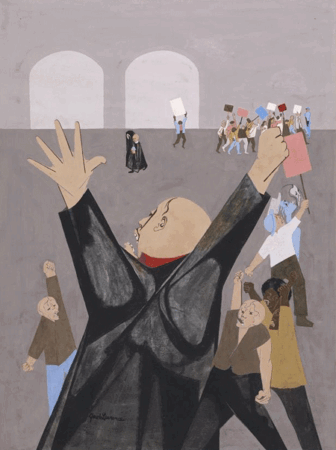Teaching with Artstor: Enhancing Children’s Literature with Artstor Images

Jacob Lawrence | The migration gained in momentum, 1940-41| Image and original data provided by The Museum of Modern Art | © 2008 Estate of Gwendolyn Knight Lawrence / Artists Rights Society (ARS), New York
Margaret Teillon
Volunteer educator
Wachovia Education Resource Center, Philadelphia Museum of Art
From a very early age children love to read, be read to, and look at pictures in books. Recognizing the joy children bring to picture books, I have developed teaching materials using selected children’s literature combined with Artstor images. My goal is to enhance literacy instruction and provide an interdisciplinary method of teaching social studies, language arts, and art appreciation. For the youngest students, I have enhanced books such as Goodnight Moon by Margaret Wise Brown; and for elementary students have developed images for Martin’s Big Words by Doreen Rappaport. Included in each enhanced book is an OIV presentation and image palette with accompanying quotes from the text, and Web links to additional creative lessons. Teachers and homeschool educators have borrowed these materials for their own students.
For example, to provide a visual narrative of the life and work of Dr. Martin Luther King, Jr. for young children, I used the picture book, Martin’s Big Words. Using images found in the Artstor Digital Library, I chose age-appropriate art that would show the connection between the story and the 1960s Civil Rights movement. I included representative African American artists and works of art reflecting a variety of media: photography, collage, painting, fabric art, sculpture, and mural. Each slide within the OIV includes quotes from the text. The book begins with the words, “Everywhere in Martin’s home town, he saw the signs.” Photographs depicting the segregated South accompany those words. Horace Pippin’s Mr. Prejudice is juxtaposed with, “Sooner or later, all the people will have to discover a way to live together.” Henry Ossawa Tanner’s Banjo Lesson provides a gentle yet powerful visual reminder of the words, “Hate cannot drive out hate. Only love can do that.” To memorialize the legacy of Dr. Martin Luther King, Jr. as presented in the text, the OIV concludes with Faith Ringgold’s Dream Two and Augusta Savage’s Lift Every Voice and Sing. After borrowing these materials, a second grade teacher reported, “Each student chose a quote from the book and made a collage to illustrate the words.” One student in her class (Shira) selected the quote “Love is the key to the problems of the world.” Shira said, “The quote is sticking off to the side. Now I’m going to make a heart and inside the heart put a key.”
- Jacob Lawrence, The migration gained in momentum, 1940-41. Image and original data provided by The Museum of Modern Art. © 2008 Estate of Gwendolyn Knight Lawrence / Artists Rights Society (ARS), New York
- Bob Adelman | Martin Luther King Jr. addresses the largest peace demonstration in history at the United Nations Plaza., April 15, 1967 | Image and original data provided by Magnum Photos | ©Bob Adelman / Magnum Photos
- Jacob Lawrence | Protest Rally, ca. 1965 | Colby College Museum of Art | © 2008 Estate of Gwendolyn Knight Lawrence / Artists Rights Society (ARS), New York
Even the youngest students can learn from this connection between Artstor images and early literature. Alexis, a Kindergarten teacher, used my enhanced version of Goodnight Moon. She printed images from the OIV, and placed these images in a pile on the floor. As she read the book, students took turns selecting matching images from the pile – which were then placed in sequential order. This activity reinforced the concept of reading from left to right by allowing them to retell the story from their sequenced images. The combination of children’s literature with Artstor images gives teachers the opportunity to form extensions to other topics, to engage students in conversation, to reinforce reading skills, and to forge creative thinking.
This essay was a 2012 Artstor Travel Awards winner.


